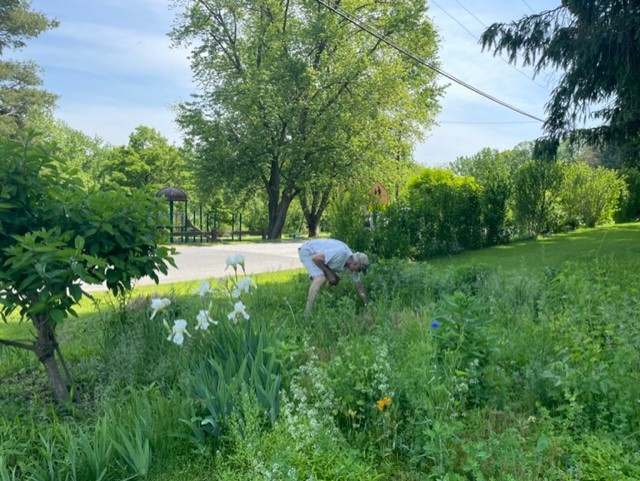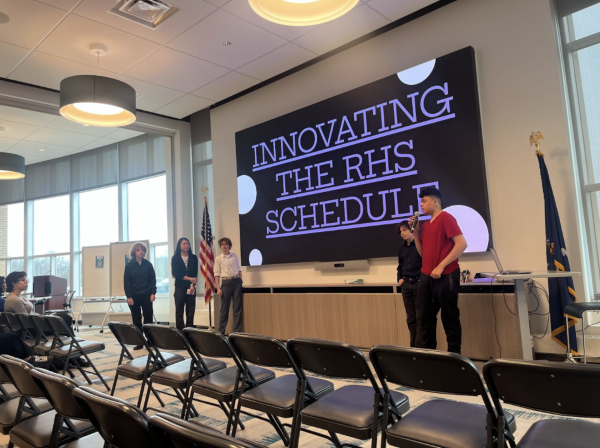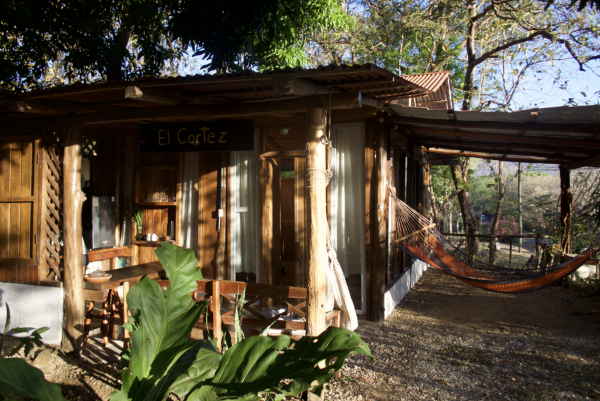What’s the Buzz About Eco-friendly Gardens in RBK?
Steps away from the RHS campus lies a pollinator’s paradise, thanks to a conscientious neighbor.
As you drive through the quaint little town of Rhinebeck rows and rows of glittering emerald lawns stretch before you as far as the eye can see. They greet you, stretch out their grassy green arms and welcome you into a community, provide a sense of belonging, assure you that the American Dream is still alive and well.
This phenomenon is by no means unique to Rhinebeck; a neatly cropped, vivid green lawn accompanying every house has long been synonymous with America and the American dream. A well kept lawn is a tangible sign that, with hard work and determination, one can achieve wealth, a sense of community, and prosperity. It is a marker of socioeconomic status; if one has a beautiful lawn one must have leisure time to tend to it as well as disposable income to spend on lawn maintenance and the funds for a home. American lawns are not walled as traditional European gardens were, but create the illusion that each household in a neighborhood is connected to the next by the green carpet that surrounds them.
As Ted Steinberg, author of American Green: The Obsessive Quest for the Perfect Lawn, puts it, “The perfect lawn is the ultimate symbol that I’ve made it in the world.”
Because of these associations, Americans have worked hard to achieve the perfect lawn. According to the Philadelphia Inquirer, “Americans spend $105 billion on lawn care each year”.
Though lawns have become an intrinsic part of American culture, they are actually detrimental to the environment.
Lawns contribute to air pollution; according to the EPA, 5% of US air pollution is attributed to mowers.
They also use an exorbitant amount of water; according to Cristina Milesi, a research scientist working at NASA’s Ames Research Center, Americans use as much as 19 trillion gallons of water… annually to care for their lawns.”
This is especially harmful in areas like California where water can be precious and scarce during droughts.
Milesi also details that Americans use “2.4 million metric tons of nitrogen-based fertilizer annually to care for their lawns.” This fertilizer then adds toxins and chemicals to wetlands, streams, and rivers.
The issue of lawns is no small scale problem either. The Washington Post says that “Turf grasses, occupying 1.9% of the surface of the continental United States, would be the single largest irrigated crop in the country” In other words, lawn grass covers over 40 million acres of the continental U.S.
Despite America’s obsession with the perfect lawn, many environmentally conscious citizens have begun trading in their traditional lawns for eco-friendly wildflower gardens. One such gardener lives in our very own town of Rhinebeck just down the street from the High School. Local Rhinebecker Tom Mckibbin Vaughan has transformed his lawn into a sanctuary for indigenous plants.
Tom’s journey towards a more sustainable garden started because he was tired of having to dedicate so much time to mowing his lawn: “I didn’t like mowing on the side hill on the way to the highschool so we put in a garden there so we wouldn’t have to mow up and down the hill. Seriously this was all because I didn’t like mowing.”
He then went to the website “Pollinator Path” where he was able to find helpful tips for how to start growing a wildflower garden.
Pollinator Path, according to Tom, is “a network of gardeners all up and down the Hudson River”.
It is a resource bursting with sustainable information; it has everything from data on why lawns are harmful, to plants native to specific zip codes.
The most helpful tip Tom has learned along the way is how to get rid of all the pre existing grass that covered his lawn.
A woman at Phantom Gardener told him to “Get heavy duty cardboard and put that down on the grass and put 3 inches of topsoil on top of that. The cardboard decays over time and you don’t have your grass growing”. This information made Tom’s transition to a wildflower garden much less labor intensive as he no longer had to rip grass out by hand.
The final steps Tom took to create a garden with indigenous plants were scattering some seeds of local plants and raking them over. Tom used “Scatter Garden Seeds Pollinator Flowers” from “Renee’s Garden”. Another worthwhile wildflower seed distributor is “American Meadows”.
Tom has found that maintaining a wildflower garden is much less labor intensive than maintaining a lawn: “Seriously, once you thrown down the seeds you forget them, at the end of the year you mow them”
He’s also found that the number of pollinators that visit his house has increased substantially.
Most importantly, since mowing was the catalyst that started this whole adventure, his mowing time has been cut in half; “It used to take me a couple hours to mow and now it takes me an hour.”
Next time you drive out of the High School, take a moment to appreciate the little green house to your left at the stop sign. Notice its garden bursting with flowers and greenery, and buzzing with pollinators. Perhaps, even take a moment to ponder how you might make a positive impact by turning your own lawn into a native wildflower garden.
Here are some helpful tips for making your garden more sustainable :
- Mow less frequently
- Participate in “Now Mow May” and don’t mow your lawn for the whole month of May.
- Let your yard go wild. Wildflowers might just appear on their own; if not, plant some wildflower seeds.
- If leaving all of your lawn wild is too far out of your comfort zone, start with leaving a small portion untouched.
- Add shrubs, trees, flowers, and clovers to your garden to encourage visits from pollinators











